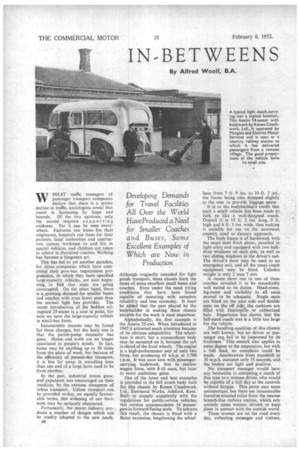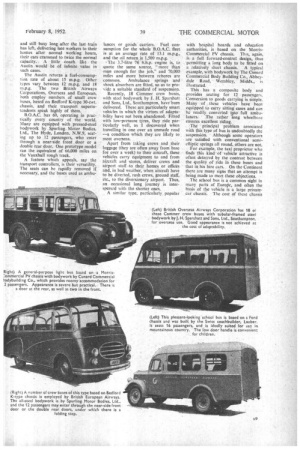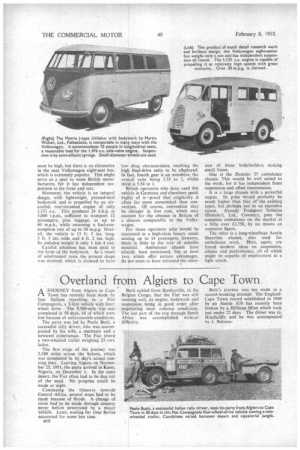IN-BETWEENS
Page 42

Page 43

Page 44

If you've noticed an error in this article please click here to report it so we can fix it.
By Alfred Woolf, B.A.
WH1LST traffic managers of passenger transport companies declare that there is a severe decline in traffic, sociologists reveal that travel is increasing by leaps and bounds. Of the two opinions, only. the second requires supporting evidence. Yet it can be seen everywhere. Factories run buses for their employees, hospitals run them for their patients, localauthorities and contractors convey workmen to and fro in special Vehicles, and children are taken to school in chartered coaches. Walking has.become a forgotten art..
This has led to yet another paradox, for those companies which have completed their post-war requirement progranimes, in which they have specified large;eapacity vehicles, are now beginning, to find that seats are going unoccupied.. On the other hand, there is a. growing demand for smaller buses and.ciSaChes with even fewer seats than the normal light .bus provides. The recent introduction of. the Seddon oilcngined 25-seater is a case in point, for here we have the large-capacity vehicle in small-bus form.
Innumerable reasons may be found for these changes, but the basic one is that the parish-pump mentality has gone. Home and work are no longer associated in people's minds. In fact, home may be anything -up to 50 miles from the place of work, but because of the efficiency of, present-day transport, it is Jess far away in travelling time than une.end of .a large farm used to be
from another. . .
In the past, industrial towns grew, and expansion was encouraged on their. outskirts, by the extreme cheapness of urban transport. Unless transport can he provided to-day, on equally favourable terms, this widening of our horizons may -be. seriously obstructed. . Fortunately, the motor, industry produces a number of designs .which can be readily adapted t6 the new needs.
n8 Although originally intended for light goods transport, these chassis form the bases of some excellent small buses and coaches. Even under the most trying conditions they have been found capable of operating with complete reliability and true economy. It must be added that •the part played by the bodybuilder in making these chassis suitable for the work is most important.
Alphabetically, the first example is the Austin 25-cwt. When introduced in 1947 it attracted much attention because of its obvious adaptability. The wheelbase is short, but a commodious body may be mounted on it, because the cab is ahead of the front wheels. The engine is a high-performance unit of only two litres, but producing 65 b.h.p. at 3,700 r.p.m. It was soon seen with passengercarrying bodywork, first in stationwagon form, with 8-10 seats, but later in more ambitious guise.
One of the latest and best examples is provided in the full coach body built for this chassis by Kenex Coachwork, Ltd., Eastmead Works, Ashford, Kent. Built to comply completely with the regulations for public-service vehicles, this version accommodates 14 passengers in forward-facing seats. To achieve this 'result, the chassis is fitted with a Baico extension, lengthening the wheel
base from 7 ft. 9 ins. to 10 ft. 3 ins.; the frame being also dropped slightly at the rear to provide luggage space.
It is to the bodybuilder's credit: that such a small vehicle has been made na look so like a well-designed coach. Overall it is 19 ft. 2 ins. long, 9 ft. high and 6 ft. 3 ins., wide, thus making it suitable for use on the narrowest country road or -factory approach.
The body frame is of hardwood, with the usual steel flitch plates, panelled in . light alloy and equipped with two halfdrop•windows on each side, as,well as two sliding windows in the driver's cab. The driver's door may be used as an emergency exit, and all the usual coach equipment may be fitted. Unladen weight is only 2 tons 7 cwt.
A recent short run in one of these coaches revealed it to be remarkably well suited to its duties. Head-room, leg-room and visibility in all seats proved to be adequate. Single seats are fitted on the near side and double seats on the off side; the cushions are filled with Dunlopillo. or rubberized hair. Experience has shown that the full-sized coach seat is a little too large for the vehicle.
The handling qualities of this chassis are well known, but no driver or passenger can fail to be impressed by its liveliness. This remark also applies in some degree to the suspension, but with a full load, no complaint could be made. Acceleration from standstill to 30 m.p.h. occupies only 15 seconds, and the brakes are light and positive.
No transport manager would have . any hesitation in entrusting a coach of this type to a woman driver, who would be capable of a full day at the controls without fatigue. This point may seem unimportant, but there are innumerable factories situated miles from the nearest branch-line railway station, which rely entirely upon women drivers to keep pent in contact with the outside world.
These women are on the road every day, collecting messages and visitors,
and still busy long after the last train has left, delivering late workers to their homes after normal working hours, their cars crammed to twice the normal caPacity.. A little coach like the Austin would be of infinite value in such cases.
The Austin returns a fuel-consumption rate of about 15 m.p.g. Other types vary between 12 m.p.g. and 18 m.p.g. The two British Airways Corporations, Overseas and European, both employ numbers of small crew buses, based on Bedford K-type 30-cwt. chassis, and their transport superintendents speak highly of them.
B.O.A.C. has 60, operating in practically every country of the world. Many are equipped with pressed-steel bodywork by Spurting Motor Bodies, Ltd., The Hyde, London, N.W.9, seating up to 12 passengers, who enter through a near-side front .door or a double rear door. One prototype model ran the equivalent of 66,000 miles on the Vauxhall rough track,
A feature which appeals, say the transport controllers, is their versatility. The seats can be rapidly removed if necessary, and the buses used as ambu
lances or goods carriers. Fuel consumption for the whole B.O.A.C. fleet is at an average rate of 13.1 m.p.g., and the oil return is 1,500 m.p.g.
The 3.7-litre 76 b.h.p. engine is, to quote the same source, " more than man enough for the job," and 70,000 miles and more between rebores are common. Ambulance springs and shock absorbers are fitted, so as to provide a suitable standard of suspension.
Recently, 18 Commer crew buses, with steel bodywork by J. H. Sparshatt and Sons, Ltd., Southampton, have been delivered. These are particularly smart vehicles in which the virtues of adaptability have not been abandoned. Fitted with low-pressure tyres, they ride particularly well, as I discovered when travelling in one over an unmade road —a condition which they are likely to meet overseas.
Apart from taking crews and .their luggage (they are often away from base for over a week) to their aircraft, these vehicles carry equipment to and from aircraft and stores, deliver crews and airport -staff to their homes or offices and, in bad weather, when aircraft have to be diverted, rush crews, ground staff, etc., to the diversionary airport. Thus, an occasional long journey is interspersed the ,
spersea witn the snorter ones.
A similar type, particularly popular
with hospital boards and education authorities, is based on the MorrisCommercial IN chassis. This, again, is a full forward-control design, thus permitting a long body to be fitted an
a relatively short chassis. A typical example, with bodywork by The Cunard Commercial Body Building Co., Abbeydale Road, Wembley, Middx., is illustrated.
This has a composite body and provides seating for 12 passengers. Conversion to goods carrying is simple. Many of these vehicles have been equipped to carry sittingcases and can bc readily converted into full ambulances. The rather long wheelbase ensures excellent riding.
The principal problem associated with this type of bus is undoubtedly the suspension. Although some operators are satisfied with conventional semielliptic springs all round, others are not.
For example, the taxi proprietor who finds this kind of• vehicle attractive is often deterred by the contrast between the quality of ride in these buses and that in his hire cars. On the Continent there are many signs that an attempt is being made to meet these objections.
The school bus is a common sight in many parts of Euroiic, and often the basis of the vehicle is a large privatecar chassis. The cost of these chassis
must be high, hut there is an alternative in the neat Volkswagen eight-seat bus, which is extremely popular. This might serve as a spur to some British manufacturers, for it has -independent suspension at the front and rear.
MOreover, the vehicle is an integral design, with lightweight, pressed-steel bodywork and is propelled by an aircooled, rear-mounted engine of only •
,1,131, c.c. This produces 24 b.h.p. at 3,000r.p.m., sufficient to transport 12 passengers, plus luggage, at up to 60 m.p.h., while returning a fuel-consumption rate of up. to 30 m.p.g. Overall, the vehicle is 13 ft. 5 ins. long, 5 ft. 5 ins, wide and 6 ft. 2 ins. high. Its unladen weight is only I ton 4 cwt.
Careful attention has been paid to the form of the bodywork. As a result of wind-tunnel tests, the present shape was evolved, which is claimed to have
low drag characteristics, enabling the high final-drive ratio to be employed. In fact, fourth gear is an overdrive, the overall ratio being 3.55 to 1, whilst third is 5.54 to I.
British operators who have used this vehicle in Germany and elsewhere speak highly of it—proof that originality is often far. more economical than convention. . Of, course, convention May be cheaper in first cost, which may account for the absence in Britain of a chassis comparable to the Volks wagen. .
For those operators who would be interested in a .high-class luxury coach seating up to 14 passengers, however, there is little in the way of suitable material. Ambulance chassis have already been mentioned, but at least two, which offer certain advantages, do not seem Ed have attracted the atten
tion of those bodybuilders making small buses.
One is the Daimler 27 ambulance chassis: This would be well suited to the work, for it has independent front suspension and offset transmission.
It is a large chassis with a powerful engine. Its price would probably be much higher than that of the existing types, but perhaps not to an excessive extent, Already Transport Vehicles (Daimler), Ltd., Coventry, puts the complete ambulance on the market at a little over £1,750, by no means an excessive figure.
The other is a long-wheelbase Austin Sheerline chassis, also used for ambulance work. Here, again, are found modern ideas on suspension, silence and performance, all of which might be capable of employment in a light coach.




























































































